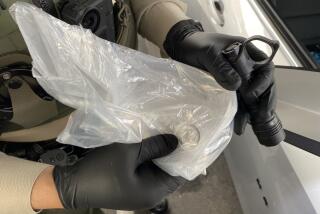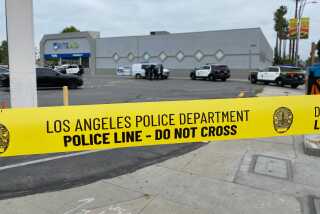Police Agencies Find New Uses for Technology
After the Cold War, law enforcement took up where the military left off in the drive to convert high technology into futuristic weapons.
As more military-based technologies become available, they are being adopted by police agencies to aid in surveillance, detection of concealed weapons, vehicle stops and nonlethal alternatives to deadly force.
While many gizmos may see action only in some “Star Wars” future, law enforcement experts anticipate others could be deployed on the streets quite soon. The trick, they say, is tailoring the devices to the needs of law enforcement and corrections officers.
Three years ago, the Los Angeles County Sheriff’s Department formed a committee made up of representatives from each of the department’s eight divisions to identify needs and find technologies to meet them.
“We have a lot of individuals and companies that come to us with solutions looking for problems.” said Sheriff’s Lt. Michael Grossman. “We are trying to do the opposite in first establishing our needs, then finding the technology to meet them.”
Grossman is assigned to the National Institute of Justice’s Office of Science and Technology in Washington, D.C. He works with federal, state and local law enforcement agencies as well as academic institutions and the military to get technology to the field, he says.
Police now have pepper spray, beanbag guns that help subdue suspects without killing them and flash-bang grenades used by special weapons and tactics teams, which startle criminals in hostage situations, usually without harming them.
What’s next? Look for these items, now under development, which could be coming soon to an officer near you.
* Frangible bullets--Made of compressed tungsten and tin, these are designed to prevent dangerous ricochets by dissolving into powder on striking metal or concrete. Developed by the U.S. Department of Energy for nuclear power plant guards, these bullets can kill or maim a human. They are considered more environmentally friendly than lead bullets but cost four times more.
* Bladder bullet--Also called the peacekeeper, this rubber bullet resembles a pencil eraser the size of a shotgun shell. Hard on each end and hollow in middle, it bursts on impact and showers the target with a liquid, such as pepper spray, marking dye or both. Reportedly more accurate than the beanbag gun, L.A. sheriff’s officials say they are interested in the concept.
* Portable Doppler radar--Packed into a metal suitcase, this transmitter can detect human movement through walls. Sheriff’s officials say the technology, currently being field-tested, could potentially be used for such problems as barricaded suspects, hostage sieges and finding missing children.
* Ring airfoil--Developed during the Vietnam War to be fired from an M-16 rifle, this thin device, about the size and shape of a doughnut, is being looked at to subdue suspects or for use in riot control. This spinning projectile delivers a stinging blow without lethal impact at close range and may be modified to carried pepper spray or other liquids.
* Ruled out--A device that fires ropes of sticky goo to ensnare suspects in a man-size spider web is too expensive and too messy to clean off the suspect and surroundings, officials say.
But regardless of how much advanced technology becomes available, there’s no “magic bullet,” Grossman said.
“Different devices and technologies will have a variety of applications under different circumstances. Less lethal does not necessarily mean noninjurious. But a bruise is better than a bullet hole.”
More to Read
Sign up for Essential California
The most important California stories and recommendations in your inbox every morning.
You may occasionally receive promotional content from the Los Angeles Times.










